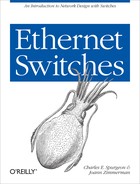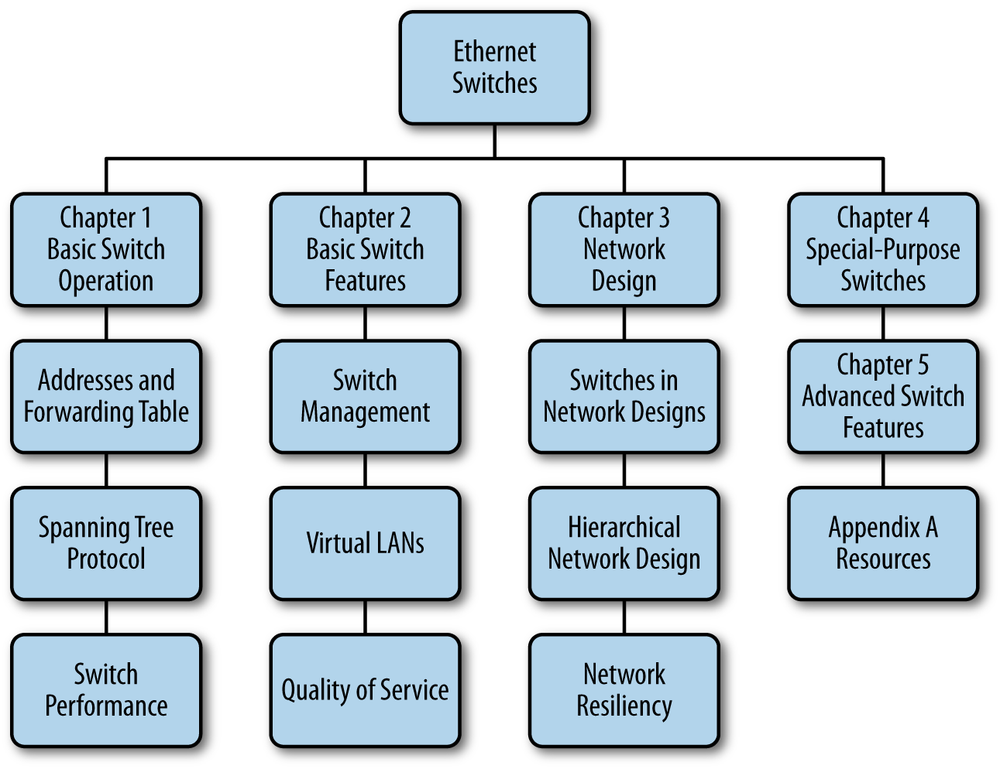Ethernet switches, also known as bridges, are basic building blocks of networks, and are so commonly used that you may not give them a second thought. It’s possible to build networks without knowing very much about how switches work. However, when you build larger network systems, it helps to understand both what goes on inside a switch and how the standards make it possible for switches to work together.
Ethernet is used to build networks from small to large, and from simple to complex. Ethernet connects your home computers and other household devices; switches for home networks are typically small, low cost, and simple. Ethernet also connects the Internet worldwide, and switches for Internet Service Providers are large, high cost, and complex.
Campus and enterprise networks often use a mix of switches: simpler and lower-cost switches are usually found inside wiring closets and used to connect devices on a given floor of a building; larger and higher-cost switches are found in the core of the network and are used to connect all the building switches together into a larger network system. Data center networks have their own special requirements, and typically include high performance switches that can be connected in ways that provide highly resilient networks.
According to industry estimates, the worldwide market for enterprise switches recorded revenues of over $5 billion per quarter in 2012, with total revenues exceeding $20 billion for the year. For the second quarter of 2012, there were 55 million Gigabit Ethernet ports shipped, and 3 million 10-Gigabit ports. At that rate, over 230 million enterprise switch ports were sold in 2012. Aside from the enterprise market, there were annual revenues of roughly $14 billion for service provider switches, resulting in total Ethernet switch revenues of roughly $34 billion for 2012. To satisfy the large and ever-increasing market for Ethernet switches, there are many varieties of switches offered at many price points.
The many kinds of switches and the many features that can be found in those switches are both very extensive topics. Covering the entire range of technology and the various ways switches can be used in network designs would require an entire book, or even several books. Instead, we will provide an introduction and a brief tutorial on how switches function, as well as how they are used in network designs. We will also provide an overview of the most important features found in switches—from the basics, to the more advanced features found in higher-cost and specialized switches.
Figure 1 shows the topics discussed in this guide. Chapter 1 provides a tutorial on basic switch operation and the spanning tree protocol. In Chapter 2, we look at the management of switches, and at some of the most widely used switch features. Chapter 3 describes the advantages of switches in network designs, and how implementing a hierarchical network design can help maintain stable operations. Chapter 4 looks at the development of specialized switches to meet the more complex requirements of large networks, data center networks, and Internet Service Providers, while Chapter 5 describes some advanced switch features. Appendix A lists resources for further information.
The following typographical conventions are used in this book:
- Italic
- Indicates new terms, URLs, email addresses, filenames, and file extensions.
-
Constant width - Used for program listings, as well as within paragraphs to refer to program elements such as variable or function names, databases, data types, environment variables, statements, and keywords.
-
Constant width bold - Shows commands or other text that should be typed literally by the user.
-
Constant width italic - Shows text that should be replaced with user-supplied values or by values determined by context.
Tip
This icon signifies a tip, suggestion, or general note.
Warning
This icon indicates a warning or caution.
This book is here to help you get your job done. In general, if this book includes code examples, you may use the code in this book in your programs and documentation. You do not need to contact us for permission unless you’re reproducing a significant portion of the code. For example, writing a program that uses several chunks of code from this book does not require permission. Selling or distributing a CD-ROM of examples from O’Reilly books does require permission. Answering a question by citing this book and quoting example code does not require permission. Incorporating a significant amount of example code from this book into your product’s documentation does require permission.
We appreciate, but do not require, attribution. An attribution usually includes the title, author, publisher, and ISBN. For example: Ethernet Switches by Charles E. Spurgeon and Joann Zimmerman (O’Reilly). Copyright 2013 Charles E. Spurgeon and Joann Zimmerman, 978-1-449-36730-5.
If you feel your use of code examples falls outside fair use or the permission given above, feel free to contact us at [email protected].
Note
Safari Books Online is an on-demand digital library that delivers expert content in both book and video form from the world’s leading authors in technology and business.
Technology professionals, software developers, web designers, and business and creative professionals use Safari Books Online as their primary resource for research, problem solving, learning, and certification training.
Safari Books Online offers a range of product mixes and pricing programs for organizations, government agencies, and individuals. Subscribers have access to thousands of books, training videos, and prepublication manuscripts in one fully searchable database from publishers like O’Reilly Media, Prentice Hall Professional, Addison-Wesley Professional, Microsoft Press, Sams, Que, Peachpit Press, Focal Press, Cisco Press, John Wiley & Sons, Syngress, Morgan Kaufmann, IBM Redbooks, Packt, Adobe Press, FT Press, Apress, Manning, New Riders, McGraw-Hill, Jones & Bartlett, Course Technology, and dozens more. For more information about Safari Books Online, please visit us online.
Please address comments and questions concerning this book to the publisher:
| O’Reilly Media, Inc. |
| 1005 Gravenstein Highway North |
| Sebastopol, CA 95472 |
| 800-998-9938 (in the United States or Canada) |
| 707-829-0515 (international or local) |
| 707-829-0104 (fax) |
We have a web page for this book, where we list errata, examples, and any additional information. You can access this page at http://oreil.ly/ethernetswitches.
To comment or ask technical questions about this book, send email to [email protected].
For more information about our books, courses, conferences, and news, see our website at http://www.oreilly.com.
Find us on Facebook: http://facebook.com/oreilly
Follow us on Twitter: http://twitter.com/oreillymedia
Watch us on YouTube: http://www.youtube.com/oreillymedia
The authors would like to thank Rich Seifert, author of The Switch Book (Wiley), and a participant on Ethernet standards committees, for his technical review and valuable comments. Of course, we are responsible for any remaining errors. Please use the contact information above to provide comments or corrections.

